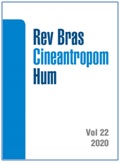Fatigue index and anaerobic power obtained in different surfaces types
DOI:
https://doi.org/10.1590/1980-0037.2020v22e66206Abstract
Due to the high intensity of competitive sports, the anaerobic power is a very important physical capacity for most sports. However, the diverse surfaces were these sports may interfere in the performance of this capacity. In running-based sports, the Running Anaerobic Sprint Test – RAST is largely used to evaluate anaerobic power. Considering the specificity of each sport, it is suggested to apply this test on the surface that it is played. Thus, the aim of the present study is to analyze the performance of RAST on different surfaces. The sample was composed by 10 subjects, mean age 20.2 ± 0.9 years old, mean height 1.8 ± 0.1 meters, mean body weight 77.4 ± 15.9 kg, and practice time of 6.0 ± 2.0 years. RAST was conducted on three different surfaces (hard, grass and sand). The maximum and minimum power and the fatigue index were compared between the surfaces. The results indicate that maximum and minimum power were lower in sand when compared to grass and hard surfaces. However, the fatigue index did not change. So, we observed that the surface is an important factor in RAST performance.
References
Barnes KR, Kilding AE. Strategies to improve running economy. Sports Med 2015;45(1):37-56.
Barbanti VJ. Treinamento esportivo: as capacidades motoras dos esportistas. Champaign: Manole; 2010.
Coelho DB, Morandi RF, Paixão RCd, Mendes TT, Borba DdA, Barros CLMd, et al. Limiar anaeróbico de 4, 0mM é capaz de estimar a máxima fase estável de lactato de jogadores de futebol em testes de campo. Rev Bras Cienc Mov 2015;23(2):32-39.
Veller C, Nowak MA, Davis CC. Extended flowering intervals of bamboos evolved by discrete multiplication. Ecology Letters 2015;18(7):653-9.
Glaister M, Lockey RA, Abraham CS, Staerck A, Goodwin JE, McInnes G. Creatine Supplementation and Multiple Sprint Running Performance. J Strength Cond Res 2006;20(2):5.
Cavazzotto TG, BRAZ AG, Ferreira SA, Queiroga MR. Efeito da aprendizagem no desempenho de repetidos testes de Wingate. Rev Bras Ciênc Esporte 2014;36(1):59-69.
Silva A, Marins J. Proposta de bateria de testes físicos para jovens jogadores de futebol e dados normativos. Rev Bras Futebol 2014;6(2):13-29.
Souza VAFA, de Oliveira Pires F, Lima-Silva AE, Bertuzzi R. Relação entre o desempenho no running based anaerobic sprint test (RAST) e a altura do salto vertical, salto horizontal e agilidade em futebolistas. Acta Bras Mov Hum 2012;2(1):34-45.
Kalva-Filho CA, Loures JP, Franco VH, Kaminagakura EI, Zagatto AM, Papoti M. Comparação da potência anaeróbia mensurada pelo teste de Rast em diferentes condições de calçado e superfícies. Rev Bras Med Esporte 2013;19(2):139-42.
Cetolin T, Foza V, Silva JF, Guglielmo LGA, Siqueira OD, Cardoso MFS, et al. Comparison of anaerobic power between tactical positions in soccer players: a retrospective study. Rev Bras Cineantropom Desempenho Hum 2013;15(4):507-16.
Dantas E. A prática da preparação física. Champaign: Roca; 2014.
Almeida B, Loureiro J. Perfil anaeróbio obtido pelo running anaerobic sprint test (rast) no período précompetitivo de atletas inscritos no campeonato paraense sub-20 de 2013. Rev Bras Futebol 2014;6(2):39-46.
Kunduracioglu B, Guner R, Ulkar B, Erdogan A. Can heart rate values obtained from laboratory and field lactate tests be used interchangeably to prescribe exercise intensity for soccer players? Adv Ther 2007;24(4):890-902.
Brechue WF, Mayhew JL, Piper FC. Equipment and running surface alter sprint performance of college football players. J Strength Cond Res 2005;19(4):821-5.
Zamparo P, Perini R, Orizio C, Sacher M, Ferretti G. The energy cost of walking or running on sand. Eur J Appl Physiol Occup Physiol 1992;65(2):183-7.
Strydom NB, Bredell GAG, Benade AJS, Morrison JF, Viljoen JH, Graan CHV. The Metabolic Cost of Marching at 3 M.P.H. Over Firm and Sandy Surfaces. Int Z Angew Physiol Einschl Arbeitsphysiol 1966;23(2):166-171.
Zagatto AM, Beck WR, Gobatto CA. Validity of the running anaerobic sprint test for assessing anaerobic power and predicting short-distance performances. J Strength Cond Res 2009;23(6):1820-7.
Keir DA, Thériault F, Serresse O. Evaluation of the running-based anaerobic sprint test as a measure of repeated sprint ability in collegiate-level soccer players. J Strength Cond Res 2013;27(6):1671-1678.
Oliver JL. Is a fatigue index a worthwhile measure of repeated sprint ability? J Sci Med Sport 2009;12(1):20-23.
Junior JHA, Marques RF, Costa HA, Marques KRM, de Almeida RB, de Oliveira Júnior MNS. Comparação do teste de Rast em jogadores de futebol e futsal de nível universitário. Rev Bras Prescr Fisiol Exerc 2012;6(34):367-371.
Gonçalves HR, de Arruda M, Valoto TA, Alves AAC, de Arruda Silva F, Fernandes F. Análise de informações associadas a testes de potência anaeróbia em atletas jovens de diferentes modalidades esportivas. Arq Ciênc Saúde Unipar 2007;11(2):115-121.
Strydom N, Bredell G, Benade A, Morrison J, Viljoen J, Van Graan C. The metabolic cost of marching at 3 mph over firm and sandy surfaces. Int Z Angew Physiol1966;23(2):166-71.
Lejeune TM, Willems PA, Heglund NC. Mechanics and energetics of human locomotion on sand. J Exp Biol 1998;201(13):2071-80.
Haisman M, Goldman R. Effect of terrain on the energy cost of walking with back loads and handcart loads. J Appl Physiol 1974;36(5):545-8.
Soule RG, Goldman RF. Terrain coefficients for energy cost prediction. J Appl Physiol 1972;32(5):706-8.
Nummela AT, Heath KA, Paavolainen LM, Lambert MI, Gibson ASC, Rusko HK, et al. Fatigue during a 5-km Running Time Trial. Int J Sports Med 2008;29(9):738-745.



